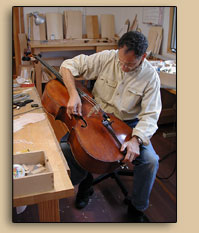







Restoration
The art of restoration has evolved greatly over the years. Innovation and a wider sense of conservation have gone hand in hand with the increasing rarity and value of wonderful old instruments.In order to be a fine restorer one must first be a fine maker, but a large and flexible tool-kit of techniques and experiences specific to restoration is also essential. I've learned from many different schools of restoration and employ innovations from fields as diverse as dentistry, x-ray technology, acoustics, and art restoration, among others. Perhaps equally important is an abiding interest in the work of those makers who have come before and a moral compass with which to guide one's hands.
As a restorer of fine instruments it is my responsibility to conserve and maintain the integrity of each individual instrument entrusted to my care. I approach each restoration on a highly individual basis, for just as no two instruments are alike, no two restorations are alike. I learn from each instrument I work on, from the original maker as well as from all those through whose hands the instrument has passed before reaching mine. If I can preserve, rather than replace, I choose to do so. I never "fix" a "problem" that is not a problem.
While there are many things one can do to preserve/restore the body and enhance the sound of a fine old instrument, there are some things that should never be done. All practices considered irreversible – such as re-graduation or varnish removal – are highly unethical. Irreversible work is wrong because it violates an instrument's historic and cultural integrity. For better or worse as seen today, a maker's fundamental work should be left and maintained for posterity. For example, some might argue that an older instrument could be made to sound better if re-graduated, which may or may not be true. Regardless, it is important to remember that what was thought to be "good" in the past is different today and will surely be different tomorrow. When one makes irreversible changes to an old instrument, it is lifted out of the context within which it was created, and something is lost forever. Aesthetics change, but cultural artifacts should not – they are our heritage.
I take great pride in being able to maximize an instrument's potential, but I strive to leave as small a "footprint" on each instrument as possible, mindful of the fact that I am just a brief stop along the path of that instrument's long life.
Web design by Palmer Media. Please contact us with any comments or problems related to this site.
Copyright © 2003-2010 Anthony Lane